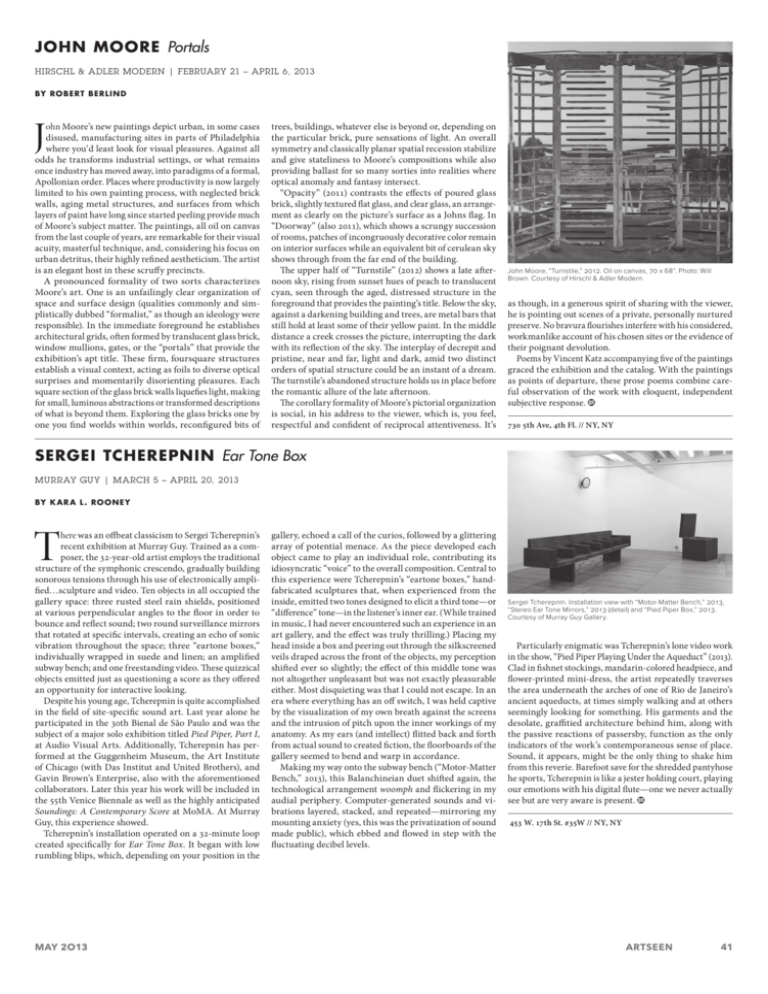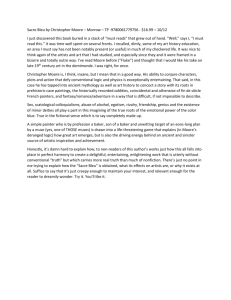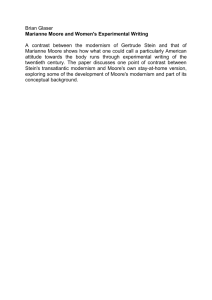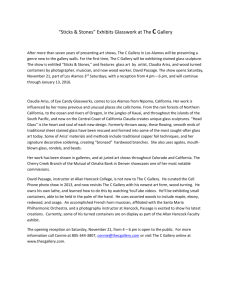"Sergei Tcherepnin: Ear Tone Box," The Brooklyn Rail
advertisement

JOHN MOORE Portals HIRSCHL & ADLER MODERN | February 21 – April 6, 2013 by Robert Berlind J ohn Moore’s new paintings depict urban, in some cases disused, manufacturing sites in parts of Philadelphia where you’d least look for visual pleasures. Against all odds he transforms industrial settings, or what remains once industry has moved away, into paradigms of a formal, Apollonian order. Places where productivity is now largely limited to his own painting process, with neglected brick walls, aging metal structures, and surfaces from which layers of paint have long since started peeling provide much of Moore’s subject matter. The paintings, all oil on canvas from the last couple of years, are remarkable for their visual acuity, masterful technique, and, considering his focus on urban detritus, their highly refined aestheticism. The artist is an elegant host in these scruffy precincts. A pronounced formality of two sorts characterizes Moore’s art. One is an unfailingly clear organization of space and surface design (qualities commonly and simplistically dubbed “formalist,” as though an ideology were responsible). In the immediate foreground he establishes architectural grids, often formed by translucent glass brick, window mullions, gates, or the “portals” that provide the exhibition’s apt title. These firm, foursquare structures establish a visual context, acting as foils to diverse optical surprises and momentarily disorienting pleasures. Each square section of the glass brick walls liquefies light, making for small, luminous abstractions or transformed descriptions of what is beyond them. Exploring the glass bricks one by one you find worlds within worlds, reconfigured bits of trees, buildings, whatever else is beyond or, depending on the particular brick, pure sensations of light. An overall symmetry and classically planar spatial recession stabilize and give stateliness to Moore’s compositions while also providing ballast for so many sorties into realities where optical anomaly and fantasy intersect. “Opacity” (2011) contrasts the effects of poured glass brick, slightly textured flat glass, and clear glass, an arrangement as clearly on the picture’s surface as a Johns flag. In “Doorway” (also 2011), which shows a scrungy succession of rooms, patches of incongruously decorative color remain on interior surfaces while an equivalent bit of cerulean sky shows through from the far end of the building. The upper half of “Turnstile” (2012) shows a late afternoon sky, rising from sunset hues of peach to translucent cyan, seen through the aged, distressed structure in the foreground that provides the painting’s title. Below the sky, against a darkening building and trees, are metal bars that still hold at least some of their yellow paint. In the middle distance a creek crosses the picture, interrupting the dark with its reflection of the sky. The interplay of decrepit and pristine, near and far, light and dark, amid two distinct orders of spatial structure could be an instant of a dream. The turnstile’s abandoned structure holds us in place before the romantic allure of the late afternoon. The corollary formality of Moore’s pictorial organization is social, in his address to the viewer, which is, you feel, respectful and confident of reciprocal attentiveness. It’s John Moore, “Turnstile,” 2012. Oil on canvas, 70 x 68”. Photo: Will Brown. Courtesy of Hirschl & Adler Modern. as though, in a generous spirit of sharing with the viewer, he is pointing out scenes of a private, personally nurtured preserve. No bravura flourishes interfere with his considered, workmanlike account of his chosen sites or the evidence of their poignant devolution. Poems by Vincent Katz accompanying five of the paintings graced the exhibition and the catalog. With the paintings as points of departure, these prose poems combine careful observation of the work with eloquent, independent subjective response. 730 5th Ave, 4th Fl. // NY, NY SERGEI TCHEREPNIN Ear Tone Box Murray Guy | March 5 – April 20, 2013 by K ar a L . Rooney T here was an offbeat classicism to Sergei Tcherepnin’s recent exhibition at Murray Guy. Trained as a composer, the 32-year-old artist employs the traditional structure of the symphonic crescendo, gradually building sonorous tensions through his use of electronically amplified…sculpture and video. Ten objects in all occupied the gallery space: three rusted steel rain shields, positioned at various perpendicular angles to the floor in order to bounce and reflect sound; two round surveillance mirrors that rotated at specific intervals, creating an echo of sonic vibration throughout the space; three “eartone boxes,” individually wrapped in suede and linen; an amplified subway bench; and one freestanding video. These quizzical objects emitted just as questioning a score as they offered an opportunity for interactive looking. Despite his young age, Tcherepnin is quite accomplished in the field of site-specific sound art. Last year alone he participated in the 30th Bienal de São Paulo and was the subject of a major solo exhibition titled Pied Piper, Part I, at Audio Visual Arts. Additionally, Tcherepnin has performed at the Guggenheim Museum, the Art Institute of Chicago (with Das Institut and United Brothers), and Gavin Brown’s Enterprise, also with the aforementioned collaborators. Later this year his work will be included in the 55th Venice Biennale as well as the highly anticipated Soundings: A Contemporary Score at MoMA. At Murray Guy, this experience showed. Tcherepnin’s installation operated on a 32-minute loop created specifically for Ear Tone Box. It began with low rumbling blips, which, depending on your position in the MAY 2O13 gallery, echoed a call of the curios, followed by a glittering array of potential menace. As the piece developed each object came to play an individual role, contributing its idiosyncratic “voice” to the overall composition. Central to this experience were Tcherepnin’s “eartone boxes,” handfabricated sculptures that, when experienced from the inside, emitted two tones designed to elicit a third tone—or “difference” tone—in the listener’s inner ear. (While trained in music, I had never encountered such an experience in an art gallery, and the effect was truly thrilling.) Placing my head inside a box and peering out through the silkscreened veils draped across the front of the objects, my perception shifted ever so slightly; the effect of this middle tone was not altogether unpleasant but was not exactly pleasurable either. Most disquieting was that I could not escape. In an era where everything has an off switch, I was held captive by the visualization of my own breath against the screens and the intrusion of pitch upon the inner workings of my anatomy. As my ears (and intellect) flitted back and forth from actual sound to created fiction, the floorboards of the gallery seemed to bend and warp in accordance. Making my way onto the subway bench (“Motor-Matter Bench,” 2013), this Balanchineian duet shifted again, the technological arrangement woomph and flickering in my audial periphery. Computer-generated sounds and vibrations layered, stacked, and repeated—mirroring my mounting anxiety (yes, this was the privatization of sound made public), which ebbed and flowed in step with the fluctuating decibel levels. Sergei Tcherepnin. Installation view with “Motor-Matter Bench,” 2013, “Stereo Ear Tone Mirrors,” 2013 (detail) and “Pied Piper Box,” 2013. Courtesy of Murray Guy Gallery. Particularly enigmatic was Tcherepnin’s lone video work in the show, “Pied Piper Playing Under the Aqueduct” (2013). Clad in fishnet stockings, mandarin-colored headpiece, and flower-printed mini-dress, the artist repeatedly traverses the area underneath the arches of one of Rio de Janeiro’s ancient aqueducts, at times simply walking and at others seemingly looking for something. His garments and the desolate, graffitied architecture behind him, along with the passive reactions of passersby, function as the only indicators of the work’s contemporaneous sense of place. Sound, it appears, might be the only thing to shake him from this reverie. Barefoot save for the shredded pantyhose he sports, Tcherepnin is like a jester holding court, playing our emotions with his digital flute—one we never actually see but are very aware is present. 453 W. 17th St. #35W // NY, NY ARTSEEN 41







